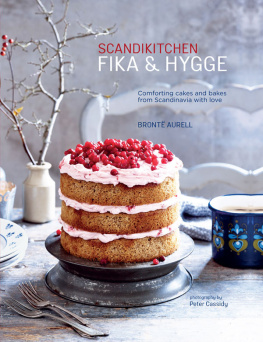Swedes are among the worlds happiest people
and for good reason. Yes, their kingdom is admirably egalitarian, progressive, and peaceful, graced with the likes of Alfred Nobel, Astrid Lindgren, and ABBA. Sure, their education is top-notch, their design is exquisite, and they are conscientious stewards of their pristine and vast environment. And certainly, their enviable work-life balance, generous maternity and paternity leaves, and family-friendly society are models for all civilized nations. Clearly the Swedes have much to be happy about, but theres another likely reason for their soaring rates of national contentment: their twice-daily ritual of fika .
Fika ( fee-k a ):
a social coffee break with ones colleagues, friends, date, or family, usually accompanied with sweet baked goods. It can be a noun (lets have fika) or a verb (shall we fika?), describing the act.
Swedes are good at many things, but if theres one thing they do exceptionally well its enjoy their coffee. Not only do they imbibe the brew, they insist upon at least one if not two coffee breaks a day, which they call fika . This ritual is at the core of Swedish culture, and while fika literally means coffee or to have coffee it also represents a happy moment, a time to slow down and focus on simple pleasures in the form of a coffee, cake, and chat.
In many cultures, the notion of drinking coffee is active and frenetic. A cuppa joe is grabbed on the go, in a take-out cup, meant to be gulped while multitasking. Its considered an energizer, a means to infuse a jolt of caffeine into the system and to rock and roll. Swedish fika is quite the opposite. Its a moment to relax and reflect, connect with friends and family, nature, or oneself. This coffee ritual is at the core of Swedish culture, and it represents a state of contentment that is quintessentially Swedish.
Coffee is a lot more than just a drink; its something happening. Not as in hip, but like an event, a place to be, but not like a location, but like somewhere within yourself. It gives you time, but not actual hours or minutes, but a chance to be, like be yourself, and have a second cup.
Gertrude Stein
How did fika begin?
The origin of fika harkens back to the mid-1600s, when coffee was first introduced to Sweden. The Arabic brew arrived in Sweden via trade with Constantinople, the capital of the Ottoman Empire and a long-standing adversary of Western Europe. This was not an auspicious introduction, and coffees provenance and tendency to perk up the populace prompted Swedens King Fredrik to deem it subversive and disruptive. Over the next 150 years or so, the king and his successors King Adolf Fredrik and King Gustav III each attempted to deter coffee consumption by either heavily taxing it (which the Swedes refused to pay) or banning it outright, which didnt stop consumptionit simply pushed the coffee movement underground, where its believed that the word kaffi became the colloquial term for the forbidden beverage.
The ban on coffee was finally lifted in 1823, which coincided with the social trend in Sweden to use back slang, or the inversion of syllables in words, so kaffi became fika . Coffee remained highly taxed in Sweden until 1951, and when the tax shackles were at last removed, coffee forged its caffeine-fueled leap into daily Swedish life. Fast-forward to present-day Sweden, now one of the worlds top three coffee consumers, where a day without a cup of coffee is unthinkable and fika is a bona fide social institution.
Today, fika is a necessary component to work-life balance. Its done at home, in cafs (called fik ), and in the workplace, where there is often a designated time for fika. Stopping and taking a break with your colleagues is not only acceptableits expected. Its almost always in the morning and often in the afternoon, as well.
In short, fika is an expression of contentment, finding balance during the day in the pleasure of sipping a cup of coffee. It doesnt get simpler than that.
Science may never come up with a better office communication system than the coffee break.
Earl Wilson
Did you know?
People who leave their desks two or three times a day to interact with colleagues show a 10 to 15 percent increase in productivity, according to a 2009 MIT study.
Is it really that simple? Yes, thanks to lagom .
Lagom is a uniquely Swedish word that does not have a precise English translation. Its directly translated as around the team, a term that dates back to the Viking era, when mead was passed from person to person, each sipping only their share, and not more, to ensure there was enough for all. It reflected contentmentthat there was just the right amount for everyone.
Nowadays, lagom reflects the concept of not too much, not too littlejust enough, a concept of moderation, simplicity, and contentment that has seeped into the Swedish psyche and culture over the ages.
Lagom
(pronounced ['la:g m]) is a Swedish word meaning just the right amount. The archetypical Swedish proverb Lagom r bst (the right amount is best), is also translated as enough is as good as a feast.
Wikipedia
Lagom applies to everything, such as ones general state of being, work-life balance, and personal consumption. It manifests in many ways, including frugality, recycling, clean design, simple food, and, of course, fika. Taking a fika break allows one to find and appreciate balance through the most simple and pleasurable ritual of enjoying a cup of coffee with a small treat, such as a cinnamon bun.






















